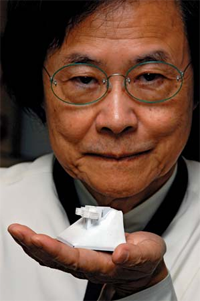Dr. Kisho Kurokawa, one of Japan's leading architects and the founding member of Anaheim University's Executive Advisory Board who served as Chair from 2002 to 2004, passed away on Friday, October 12th, 2007 at the age of 73. A spokeswoman at Tokyo Women's Medical University Hospital, where he was hospitalized on October 9th with an intestinal ailment said he died of heart failure. Over 550 newspapers and publications around the globe reported Kisho Kurokawa's death.
The Japanese architect who led the "Metabolism Movement" and based his designs on themes including ecology and recycling, made his world debut in 1960. At age 26, he led a style known as the Metabolism Movement, advocating a shift from "machine principle" to "life principle" in his literary work and architectural designs based on themes including ecology, recycling and intermediate space. His theory of "Symbiosis" became globally known. Read more at Wikipedia or visit Kisho.co.jp
His major works can be found throughout the world including the Kuala Lumpur International Airport in Malaysia, the National Art Center in Tokyo's posh Roppongi district, the new wing of the Van Gogh Museum in Amsterdam, and Toyota Stadium for the 2002 World Cup. In addition to his work in architecture, Dr. Kurokawa sat on numerous governmental advisory boards in Japan, China and Kazakhstan, and ran in the 2007 election for Tokyo Governor.
 Dr. Kisho Kurokawa
Dr. Kisho Kurokawa
Japanese Prime Minister Yasuo Fukuda stated, "(Kurokawa) demonstrated his genius to open a new passage to architecture". According to Anaheim University President Dr. David Nunan, "Dr. Kurokawa has been a spiritual leader for all of us as a founding Executive Advisory Board member, Chair of the Executive Advisory Board, and as a stakeholder in our institution. It was an honor for us to provide our facilities in California to serve as his U.S. Office. We like to think of him as a builder of dreams, and his diverse efforts went far beyond architecture, touching on politics, business, science, art, culture and philosophy. He was one of our strongest supporters and he will be sadly missed by all of us at Anaheim University".
Born in Nagoya, Japan in 1934, Kurokawa graduated from Kyoto University's architecture department before earning a doctoral degree from Tokyo University under Kenzo Tange, who was hailed as the architect of some of the most beautiful structures of the 20th century.
Kurokawa's design of the Kuala Lumpur airport won the 2003/2004 grand prix by Italy's Dedalo-Minosse International Prize, and was also certified as a sustainable airport by the United Nations' Green Globe 21 in 2003. Dr. Kurokawa's numerous awards include the Gold Medal from France's Academy of Architecture in 1986, the 48th Japan Art Academy Award in 1992 (the highest award for artists and architects in Japan), the AIA Los Angeles Pacific Rim Award in 1997, and most recently the Chicago Athenaeum Museum International Architecture Award in 2006. His travelling exhibtion "Kisho Kurokawa" has been viewed by over 800,000 people, and he was the first Japanese architect to become an Honorary Fellow of the Royal Institute of British Architects and the Union of Architects in Bulgaria.
